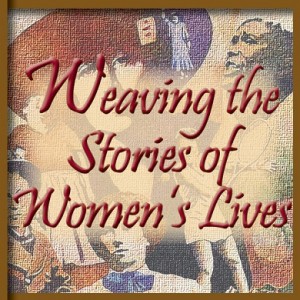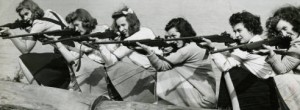
The 2015 theme of Women’s History Month is Weaving the Stories of Women’s Lives. Photo from the National Women’s History Project.
As I pondered the task before me, writing the blog post to introduce March as Women’s History Month, I found myself wondering…what is the history of Women’s History Month? When did it start and what were the reasons? There is irony and humor in the history of Women’s History Month but that aside, how did it all start?
An International Women’s Day began in the early 20th century, first at the end of February than later, in March. The more recent history of celebrating women’s history started in 1978 when the school district of Sonoma, CA, participated in Women’s History Week, an event designed around the week of March 8th, International Women’s Day. The idea began to take off in 1979 at a summer conference on women’s history at Sarah Lawrence College. There participants heard of the success of the Sonoma County’s Women History Week celebration, wanted to carry it to their own organizations, communities, and schools, and agreed to work to secure a National Women’s History Week.
In February 1980, President Jimmy Carter issued a presidential proclamation declaring the week of March 8, 1980, as National Women’s History Week. Also in 1980, the National Women’s History Project (NWHP) was founded in Santa Rosa, California by Molly Murphy MacGregor, Mary Ruthsdotter, Maria Cuevas, Paula Hammett and Bette Morgan to broadcast women’s historical achievements.
Responding to the growing popularity of Women’s History Week, in 1981, Sen. Orrin Hatch (R-Utah) and Rep. Barbara Mikulski (D-Maryland) co-sponsored the first Joint Congressional Resolution proclaiming a Women’s History Week. Congress passed their resolution as Pub. L. 97-28, which authorized and requested the President to proclaim the week beginning March 7, 1982 as “Women’s History Week. The Week took off in popularity and by 1986, fourteen states had declared March as Women’s History Month.
In 1987, after being petitioned by the National Women’s History Project, Congress passed Pub. L. 100-9 which designated the month of March 1987 as Women’s History Month. Various Congressional resolutions and presidential proclamations later, March is clearly cemented as Women’s History Month.
I’ve been interested in women’s history since my college days in the 1980s. I knew some of the history of Women’s History Month but not all of it. My first surprise was learning that the month had roots in International Women’s Day that started at the turn of the 20th Century.
Fast forward to the late 1970s and early 1980s and we come to my next surprise. Who knew Sen. Orrin Hatch (R-Utah) and Rep Barbara Mikulski (D-Maryland) sponsored anything together? For readers who don’t know who Hatch and Mikulski are, Google them to totally understand the magnitude of this cooperation. Their joint legislation only goes to show the tremendous bi-partisan support for a month to honor women and their contributions throughout history.

A photo of Mundelein College students in the Marksmanship Club, circa 1940, from the WLA’s collection.
Here we are in 2015 celebrating Women’s History Month. I’ve taken to joking that Women’s History Month is made for the WLA. To celebrate the Month, there will be a feature every week on the WLA website highlighting a woman or organization from our collections.
In addition, for those on Loyola’s campus, a display in Cudahy Library will feature artists from the WLA collections. Very different artists, I might add. If you’re in the Loyola neighborhood stop by Cudahy and take a look.
Enjoy Women’s History Month!
Nancy became Director of the WLA in spring, 2013. Prior to that, Nancy worked as an archivist and records manager at a wildlife research facility for the USDA in Colorado. Nancy has worked in the archival field since 1999. When not working on all things archival, Nancy enjoys spending time with her family and knitting.
Loyola University Chicago’s Women and Leadership Archives Blog is designed to provide a positive environment for the Loyola community to discuss important issues and ideas. Differences of opinion are encouraged. We invite comments in response to posts and ask that you write in a civil and respectful manner. All comments will be screened for tone and content and must include the first and last name of the author and a valid email address. The appearance of comments on the blog does not imply the University’s endorsement or acceptance of views expressed.

